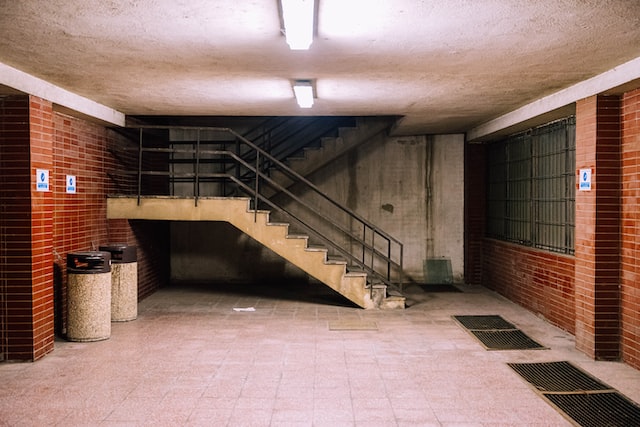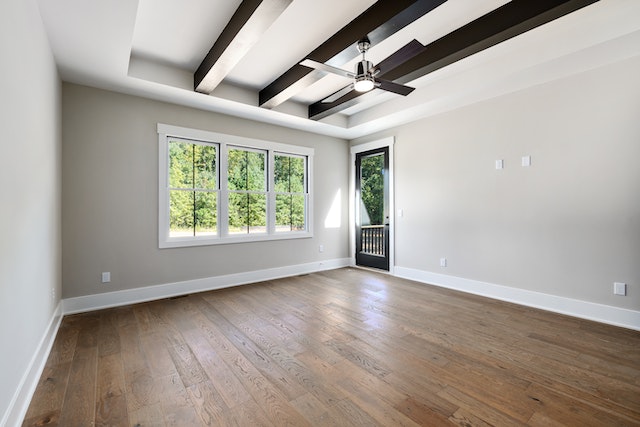What Color to Paint Basement Ceiling?
Your basement has the potential to be transformed into the breathtaking haven of your dreams if you choose the proper ceiling color. There is a shade of paint that will complement any atmosphere, whether you want your basement to have a light and airy mood or be conducive to a night in front of the television. The following is a list of the most suitable hues for painting the ceiling of your basement.
#1. Disguising Black
A coat of paint with a deep, dark color can disguise any flaws in your ceiling. When everything in an open ceiling is painted black, the cables, pipes, and beams take on the appearance of being seamlessly integrated. A dark black color not only makes the ceiling disappear but also blurs the lines of the room, giving the impression that the space is bigger than it really is.
The use of black paint not only helps to conceal the electrical lines, but it also lends an air of individuality to the space. Black, with its daring undertone, may give your basement the wow factor that it so desperately needs. Additionally, the use of darker hues has the effect of making a room seem more inviting and comfortable.
A ceiling that is painted black is an excellent decision to make if your basement includes a television or a home theater. In addition to providing an atmosphere reminiscent of a movie theater, it makes the room seem cozier and warmer. And if you paint the ceiling black, you have the option of selecting neutral furniture for a more elegant aesthetic or colorful accents for a place that is more vibrant.
After painting your ceiling black, you will need to be more vigilant about spotting dust and cobwebs since they will show out more against the dark background. However, if you use a duster that has a long handle, you won’t have any trouble reaching even the most inaccessible areas.
#2. Illuminating White
White is the color that reflects the most light of any other paint color, so using it in your basement may help bring more light down there. If there is not enough natural light in your basement, white should be your color of choice.
If you want to create a kid’s room, a playroom, or a more vivid living area downstairs, a ceiling that is white is a terrific choice. It gives off an atmosphere that is cheerier and more brilliant than one that has a dark ceiling, and it is also quite flexible. You may produce the atmosphere you desire by using a variety of colors in your furniture and other decorative elements.
If you want to paint the exposed ceiling of your basement white, you will need at least two coats, and maybe even more, to effectively cover the beams, cables, and pipes in the ceiling. Even after applying a number of layers of white paint, the knots in the wood beams in your ceiling may still be visible.
After painting your ceiling white and installing can lighting, the exposed wiring might provide your space an artistic or industrial appearance, depending on your preference.
#3. Light Gray
A ceiling in a light gray color might give the impression that the area is more inviting. It also provides a neutral appearance for your basement, which gives you alternatives when it comes to the furniture and decoration you want to use. When used on an open ceiling, gray is a better option than white for hiding faults since it is less striking than black.
When it comes to gray paint colors, you have a lot of leeway to experiment with undertones like blue, green, and brown. If you don’t want to go all in with color, you may still infuse some fun into the design. If you want the paint to seem smooth, you should probably apply at least two coats of a light gray color.
In addition to lighter tones of gray, you also have the choice of going with a charcoal gray for a dark ceiling that isn’t quite as intense as black. A darker shade of gray conceals more of an exposed ceiling and lends an air of drama to the space.
#4. Creamy Beige
A stunning glow may be achieved in your basement by painting the walls a light beige or cream color. Beige, especially one with undertones of brown or orange, exudes a sense of coziness and warmth without being overbearing.
Depending on the mood you want to create in the room, choose either bright or dark walls to complement the ceiling. A area designed to function as a playroom or family room might benefit from having lighter walls and a beige ceiling. If you paint the walls a deeper color, the contrast against the beige ceiling will be more striking, and the room will seem warmer. You might also try to match the colors of your walls and ceiling to get a flush effect, which would make your ceiling seem to be taller.
#5. Sky Blue
Even if your basement is located below earth, there’s no reason the ceiling can’t be designed to seem like the sky above. A coat of paint in the color sky might give your basement an air of whimsy. It will provide the impression that you are outside in the fresh air if you combine it with white or off-white walls. If your basement has a walkout slider or any other windows, this feeling will be amplified. Your blue ceiling will definitely stand out and make a statement thanks to the contrast provided by the white.
In addition to lighter shades of blue, you also have the option of going for a darker blue shade. This does not provide the impression that you are looking up at the sky, but it does have the other advantages that a black ceiling offers, such as disguising faults, creating the sense of a bigger room, and being suitable for a movie night.
You should do some experimenting on a small section of your ceiling first to see whether or not a non-neutral hue, such as blue, would work well in the room you want to use it in.







